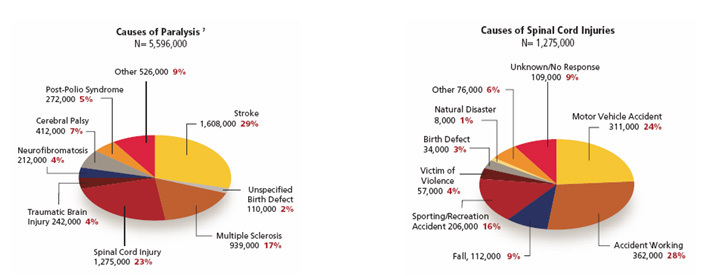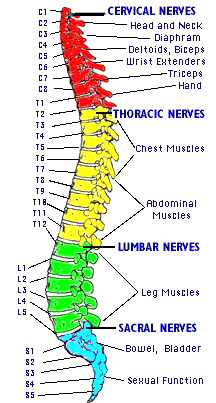 |
|
|
|
|
| |
|
|
|
|
|
|
|
|
|
|
|
|
| |
Some basic questions and answers...
What is Spinal Cord Injury? Spinal Cord Injury (SCI) is damage to the spinal cord that results in a loss of function such as mobility or feeling. Frequent causes of damage are trauma (car accident, gunshot, falls, etc.) or disease (polio, spina bifida, Friedreich's Ataxia, etc.). The spinal cord does not have to be severed in order for a loss of functioning to occur. In fact, in most people with SCI, the spinal cord is intact, but the damage to it results in loss of functioning. SCI is very different from back injuries such as ruptured disks, spinal stenosis or pinched nerves.
A person can "break their back or neck" yet not sustain a spinal cord injury if only the bones around the spinal cord (the vertebrae) are damaged, but the spinal cord is not affected. In these situations, the individual may not experience paralysis after the bones are stabilized.
|
|
|
|
| |
What is the spinal cord and the vertebra? The spinal cord is about 18 inches long and extends from the base of the brain, down the middle of the back, to about the waist. The nerves that lie within the spinal cord are upper motor neurons (UMNs) and their function is to carry the messages back and forth from the brain to the spinal nerves along the spinal tract. The spinal nerves that branch out from the spinal cord to the other parts of the body are called lower motor neurons (LMNs). These spinal nerves exit and enter at each vertebral level and communicate with specific areas of the body. The sensory portions of the LMN carry messages about sensation from the skin and other body parts and organs to the brain. The motor portions of the LMN send messages from the brain to the various body parts to initiate actions such as muscle movement.
The spinal cord is the major bundle of nerves that carry nerve impulses to and from the brain to the rest of the body. The brain and the spinal cord constitute the Central Nervous System. Motor and sensory nerves outside the central nervous system constitute the Peripheral Nervous System, and another diffuse system of nerves that control involuntary functions such as blood pressure and temperature regulation are the Sympathetic and Parasympathetic Nervous Systems. |
|
|
|
|
The spinal cord is surrounded by rings of bone called vertebra. These bones constitute the spinal column (back bones). In general, the higher in the spinal column the injury occurs, the more dysfunction a person will experience. The vertebra are named according to their location. The eight vertebra in the neck are called the Cervical Vertebra. The top vertebra is called C-1, the next is C-2, etc. Cervical SCI's usually cause loss of function in the arms and legs, resulting in quadriplegia. The twelve vertebra in the chest are called the Thoracic Vertebra. The first thoracic vertebra, T-1, is the vertebra where the top rib attaches.
Injuries in the thoracic region usually affect the chest and the legs and result in paraplegia. The vertebra in the lower back between the thoracic vertebra, where the ribs attach, and the pelvis (hip bone), are the Lumbar Vertebra. The sacral vertebra run from the Pelvis to the end of the spinal column. Injuries to the five Lumbar vertebra (L-1 thru L-5) and similarly to the five Sacral Vertebra (S-1 thru S-5) generally result in some loss of functioning in the hips and legs.
What are the effects of SCI? The effects of SCI depend on the type of injury and the level of the injury. SCI can be divided into two types of injury - complete and incomplete. A complete injury means that there is no function below the level of the injury; no sensation and no voluntary movement. Both sides of the body are equally affected. An incomplete injury means that there is some functioning below the primary level of the injury. A person with an incomplete |
|
|
|
|
|
|
|
|
|
|
| able to move one limb more than another, may be able to feel parts of the body that cannot be moved, or may have more functioning on one side of the body than the other. With the advances in acute treatment of SCI, incomplete injuries are becoming more common. The level of injury is very helpful in predicting what parts of the body might be affected by paralysis and loss of function. Remember that in incomplete injuries there will be some variation in these prognoses. |
|
|
Cervical (neck) injuries usually result in quadriplegia. Injuries above the C-4 level may require a ventilator for the person to breathe. C-5 injuries often result in shoulder and biceps control, but no control at the wrist or hand. C-6 injuries generally yield wrist control, but no hand function. Individuals with C-7 and T-1 injuries can straighten their arms but still may have dexterity problems with the hand and fingers. Injuries at the thoracic level and below result in paraplegia, with the hands not affected. At T-1 to T-8 there is most often control of the hands, but poor trunk control as the result of lack of abdominal muscle control. Lower T-injuries (T-9 to T-12) allow good truck control and good abdominal muscle control. Sitting balance is very good. Lumbar and Sacral injuries yield decreasing control of the hip flexors and legs.
Besides a loss of sensation or motor functioning, individuals with SCI also experience other changes. For example, they may experience dysfunction of the bowel and bladder,. Sexual functioning is frequently with SCI may have their fertility affected, while women's fertility is generally not affected. Very high injuries (C-1, C-2) can result in a loss of many involuntary functions including the ability to breathe, necessitating breathing aids such as mechanical ventilators or diaphragmatic pacemakers. Other effects of SCI may include low blood pressure, inability to regulate blood pressure effectively, reduced control of body temperature, inability to sweat below the level of injury, and chronic pain
How many people have SCI? Who are they? Approximately 450,000 people live with SCI in the US. There are about 10,000 new SCI's every year; the majority of them (82%) involve males between the ages of 16-30. These injuries result from motor vehicle accidents (36%), violence (28.9%), or falls (21.2%).Quadriplegia is slightly more common than paraplegia. |
|
 |
|
|
| |
|
|
|
 |



